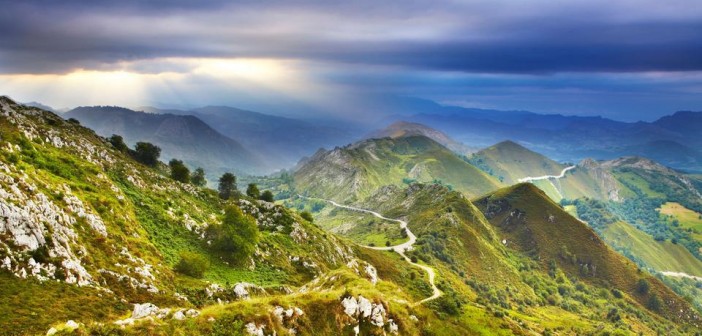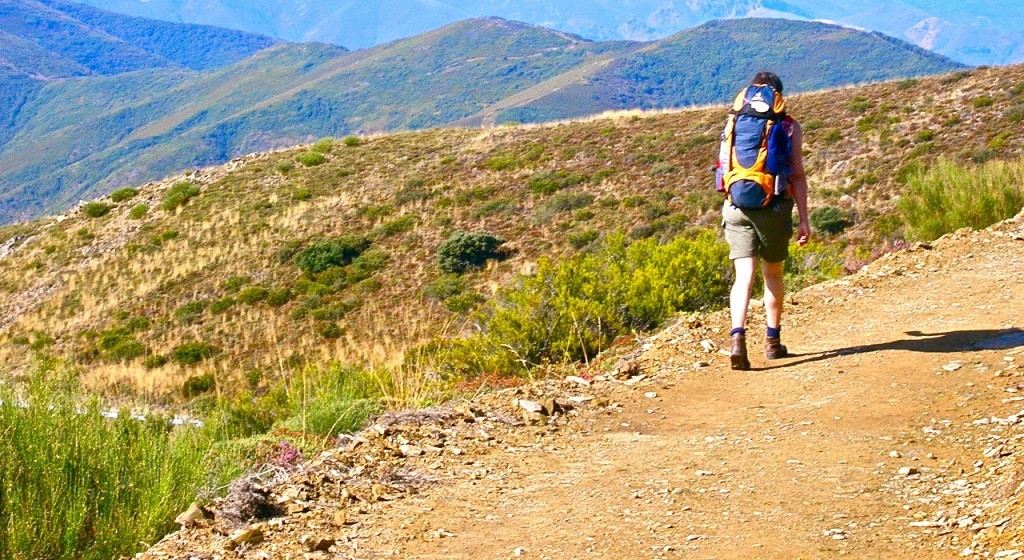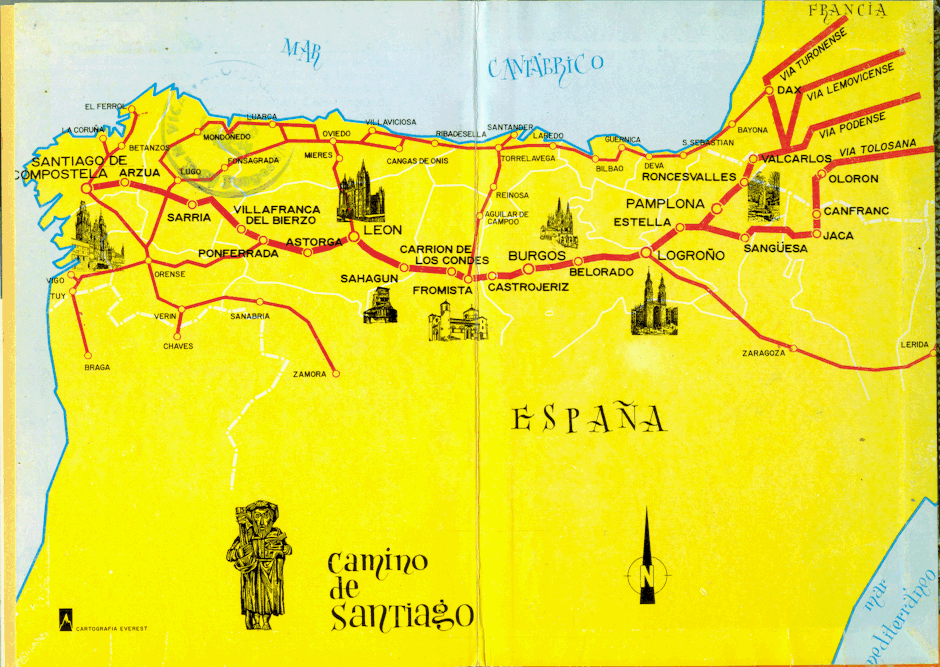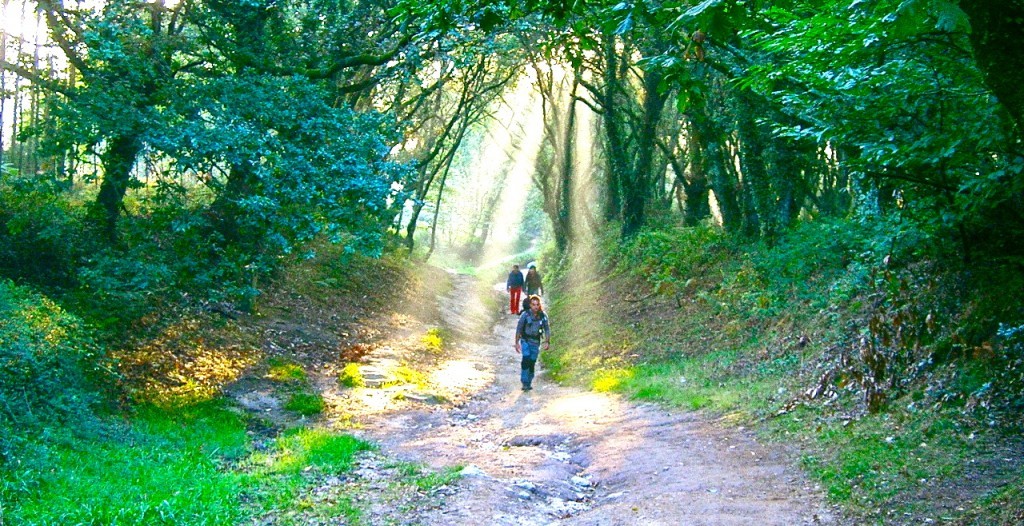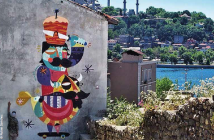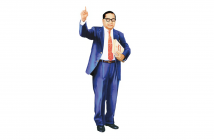The sun is hard; it’s 2 p.m and I’m still one hour away from Astorga, the goal for the day. For the past four hours I have distanced myself from the group and have not talked to anyone in between. Listening to the birds singing and cows mooing is a refreshment to my mind, while the pointy rocks I step on feel like sharp spears reminding me of my blisters. Why am I doing this trek? It wasn’t the first time I asked myself this, but it was the last as soon as I layed eyes upon the sign: “La Casa de los Dioses”, the house of Gods.
A shirtless David greets me with a wide smile. Muscles ripped, tattooed arm and long hair, I mentally placed him at 30 years old. He’s actually in his 40s. He too had completed the Camino de Santiago six years ago.
“[It’s] an incredible experience that changed my life forever”, he explained. Shortly after he quit his job, left his house and decided to help pilgrims along the way between Santibañez de Valdeiglesias and San Justo de la Vega by selling organic food and drinks. The pilgrim pays whatever he thinks it’s worth, also known as “donativo”. This place is what he’s called home for the past four years. With no electricity nor running water David is all about sharing, either lending his guitar for lonely chords to find meaning on the air, or by talking about life itself. “The problem with society today is greed. Humans always want more and more. I decided to give and give.”
All the money he makes at his little “food truck” is used to buy more organic groceries delivered by a truck every week to provide food for the next pilgrims. He does not miss electricity, let alone cellphones or laptops. Water comes from the rain or a river two kilometers away. A mattress on a makeshift bed is his bedroom. I wave goodbye at him with the traditional “Buen Camino” pilgrims greet each other. “Feliz Camino” he replied. I find good friends also sharing David’s food among themselves and knew that those 15 minutes with David would stay with me forever.
But what is the “Camino” and why can it change people so drastically?
Camino de Santiago, or The Way of St. James, is a pilgrimage journey across Spain and one of the main ones for Christians, alongside Jerusalem and Rome. Santiago was one of the Apostles of Jesus and his remains are believed to be enshrined in the Cathedral of Santiago, in Spain. Traditionally the pilgrim would leave his or her own house and start walking towards the cathedral, which is what David did in Barcelona.
My name is Robert Born, I am 28 years old, born and raised in Brazil, so it was physically impossible to walk across the Atlantic Ocean to reach the Cathedral of Santiago in Spain. Therefore I took one of the traditional routes, the most famous one: Camino Francés, or the French way. Starting from Saint Jean Pied de Port, a French town near the Spanish border, I had to cross the Pyrenees into the Peninsula through Roncesvalles and before reaching Santiago I would also go through some big Spanish cities such as Pamplona, Logroño, Burgos, León, Astorga and Sarria. I started on June 10th until July 10th, plus another three days hiking until the end of the world in Finisterre, completing 862 kilometers.
One can easily describe the core of the Camino in a few sentences. Wake up at 5 a.m. Eat an apple or banana. Choose between 3 sets of clothes to wear. Put on smelly shoes. Carry a heavy backpack. Start walking for two hours non-stop before the first real breakfast. Keep walking for another three or four hours. Find accommodation. Take a shower. Eat dinner. Sleep. Repeat for the next 30 days. But to reach Santiago de Compostela is not the goal. The way and its teachings are the goal and believe me when I say that a pilgrim will change after the Camino.
Nameless
At the beginning no one has a name. You actually do, but since you are meeting around 15 new people every day it is hard to keep track of people`s names. Therefore your name blends with the place you come from. Evidently I was Brazil and I started remembering people as Justin Holland or Daniel Taiwan. Before you notice you start introducing yourself first by the country you’re from, followed by your actual name.
Along with being nameless a pilgrim gets a blank field for his personality as well. You can be anyone in the Camino. Mary Canada struck me as a talkative person; she found it easy to make new friends and make people feel comfortable around her with her jovial and funny attitude. A short brunette, it was hard to resist the urge to hug and throw her in the air after one of her impressions. She confessed being a shy person back in Canada. That surprised me. I myself find it hard to initiate conversation with strangers, although it felt natural during the Camino.
The first week is mainly physical pain. Legs, ankles, back will feel sore in spots you did not know you had muscles. Talking about the condition of your feet becomes the introductory conversation to new faces. The counting of blisters was my personal highlight, as I ended up with 26 – getting a silver medal on a secret championship, behind Amanda from United States who stopped counting after blister number 30 during the third week.
The physical pain gives space to physical happiness. After conquering steep mountains, plain fields and dense forests I started feeling the joy of overcoming what I thought was my physical limit. I was carrying an 18 kilo backpack with me – something every guide advises against, unless I weighed 180 kilos, which is double my actual weight – I walked around 25 kilometers every day and I only ate a proper meal once a day.
In the words of Magnus Denmark: “I’ve still got a long way to go, but I look back and realize everything I already conquered and I’m proud of it”. He mentioned that the day I met him while he was struggling with pain on his right foot. Unfortunately he had a bone injury and had to go back home earlier than expected. “But I will come back and continue from where I stopped”, he swore before entering a taxi to the next city.
To have a new personality does not mean you need to pretend to be strong. Both physically and mentally. Physically everyone can help you. During the first few days while walking alone I was always asked by people if I was ok or if I needed any help when I was just taking a water break. I once saw a group of 8 people, strangers to each other, who stopped to help Rachel from United States with a blister on her right foot. This is Camino!
Even though you might spend a few hours with total strangers, only a few minutes are needed to create a bond. Your fellow pilgrim is going through the same physical problems as you are. Psychologically can be different, which opens up deep conversations. I had conversations with people I’d known for roughly three hours that I never had with my closest friends back in Brazil. One day in the Camino feels like a month socially speaking.
“Ask and the Camino provides”
This quote was from Mary Canada somewhere along the way, but it was true from the beginning. On my first hostel, before the walking started, I met Sweden Michael, a tall strong bearded blonde in his 40s. During the first day of walking, I met Danish Daniel, a smiley blonde and very white Scandinavian guy in his mid-20s. When I reached the first albergue (pilgrim’s hostel) I wished to see Daniel and Michael again, and lo and behold, Daniel was right in front of me when I checked in the hostel in Roncesvalles, while Michael was coming down the stairs. Ask and the Camino provides.
But there is a “truer” quote that says “The Camino provides what you need, not always what you ask for.” This became clear to me on the fourth day when, after walking and meeting Michael and Daniel along the way, I was in so much pain that I could not reach the same city they were planning to stop at. Me and a new friend, German Naomi, stayed one city back, around 5 kilometers, only to push the limit the following day and try to find them. One day difference in the Camino feels like being in an entire new generation of pilgrims. If you stay back one day, or if you push your limit and go ahead a bit more, you will find a complete set of new people.
According to every person on the Camino, including those who worked at albergues, all accommodations in Pamplona were closed due to San Fermin – the street bull racing tradition – so people were advised to stay one city before or after Pamplona. Naomi pulled out her German guide book and pointed at a German albergue in the outskirts of Pamplona city center. Luckily it was open and it still had three beds available. Danke schön Deutschland. I never saw Michael or Daniel again, but I did meet Rachel from United States in the albergue. Her first words to me that day: “You’re here. Now everyone who is cool is here”, she shouted to the next bedroom. I barely knew her, although I knew she was from Houston, Texas and I shared a joke with her when, having to stop along the way to pop a blister, I said “Houston we have a problem.” I couldn’t resist.
Rachel was in fact shouting to Sanne from Holland, but I called her Dutchie, Marie from Norway, Julia from Germany, Rachel’s friends also from the United States Katie and Mike, Tomi from Italy and Mary Canada. That group, with some temporary additions and some goodbyes were now my group along the way until the end of my journey.
To have a group went against everything I believed the Camino was about. This pilgrimage was supposed to be a silent walk, a journey to find your true self and not to keep walking in the pace of other people. That can be true if you want to, but I found out there was nothing more rewarding than seeing friendly faces when you take a break or when you check into an albergue. After all, happiness is only real when shared. “I meet a lot of people, but I don’t have the time to create a strong bond with them”, said a sad pilgrim who was doing the Camino in reverse. No wonder I do not recall his name.
Life in the Camino is simple. A swimming pool is the greatest remedy after walking five hours under a punitive hot sun. Smaller luxuries can also mean the world, such as a kitchen to cook proper food; blackberries, grapes, apples and figs for free on the trail; hot showers and a bed instead of a bunker; a mini market with more than three option of fruits; a guitar for the pilgrims.
The group did well without a guitar also. Norway Marie would sing acapella followed by the rest of the group who did not have the same lung experience as she did. If it wasn’t her, Sanne Dutchie would spin around with her walking sticks playing air guitar and screaming loud and clear making everyone laugh.
In the spirit of meeting more people, I disconnected from the group only to meet a couple of Danish and German pilgrims along with Tina from Slovenia – a psychologist and enigmatic person who would get stories out of you…but rarely share some of her own. She, like myself, did not want to tag with any group and was constantly walking faster or slower to meet new people. We ended up walking together all the way to the end of the world, with occasional mismatches. She ended up mingling with a group who later merged with mine. “I am so happy I am part of a group”, she confessed on the final week of the Camino. The Camino provides what you need, not always what you ask for.
Along the way you meet incredible people with which I could write a book about it, even though I spent a day or two with them, sometimes a few minutes. Albán is a guy we nicknamed Jerusalem although he is from France. He walked from his doorstep to Jerusalem and then started walking from there to Santiago de Compostela in Spain. The day I was entering the city he was leaving. “Walking back home now, another two months on the road”, he explained.
Jeróme from France was practically living inside a movie script doing the Camino. He was also spreading his mom’s ashes on the way. He told me his mother never expressed the desire and his two siblings were against it. “I’m doing it for myself. Not for her or for anyone else actually. I discovered that I’m doing it because I’m selfish and I’m not proud of it anymore.”
Gregori from Belgium is finishing his studies, but felt a “call” to do the Camino this year. Very religious, he would always have something deep to talk about and often found meaning in ordinary moments. Although he said he does not have many friends back home, he was always around people who loved him in the Camino. His life is a puzzle to many, as he shares only enough and at the right time, making people comfortable with his kindness.
During the walking: you are nameless; you can have the personality you want; you do not have a boss to tell you what to do and how; you do not have to walk 30 kilometers if you don’t want to; you can stop whenever you want and people will still see you as a winner, not a quitter. This is the personal universe of the Camino.
Combine that with social factors which are essentially nice and interesting people all around you, everywhere you go, and it’s hard not to understand why people embrace this lifestyle with such passion. Maybe for the first time you are 100% in control of your life. The ultimate freedom in this contemporary world.
Earlier I told you that the Camino will change you. I lied. The Camino does not change people. It is you, who changes you. To quote Tina Slovenia: “The Camino only makes you think. It makes your brain work and forces you to think about stuff that matters to you the most. After thinking, you decide what needs to change, but you can only do it yourself.” So what comes after the journey ends? I leave you with a personal metaphor I developed along the Camino:
The Camino feels like a different universe. But more detailed. It is like a dark room in our own universe. As soon as you enter it, somehow you are gifted with a candlelight, although it is not lit. In the beginning you walk, stumble across something or even someone, but you keep walking. Once in a while someone from the outside will come into the dark room but with an internal light of their own – those people for me were Belgium Gregori and Mary Canada, both willing to help anyone anyway possible. They stumbled across me and, kind souls as they are, they lit up my candle. I felt blessed and started sharing my light with more people I came to know. In no time, the room is filled with light. The Camino is no longer a strange dark place. You can see the end, and the last door you will open inside this parallel universe. And once you are out, what happens? Do you dump your candle in the nearest garbage bin and go back to your old life? Or is the wind of the ‘real universe’ too strong to blow off your flame?


